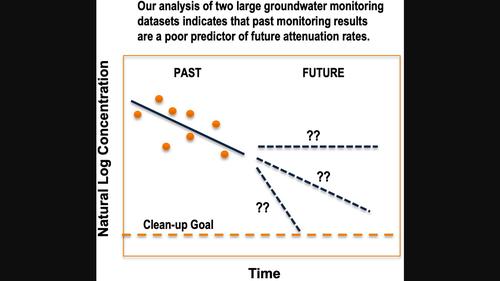当前位置:
X-MOL 学术
›
Groundw. Monit. Remediat.
›
论文详情
Our official English website, www.x-mol.net, welcomes your feedback! (Note: you will need to create a separate account there.)
Forecasting Groundwater Remediation Timeframes: Site-Specific Temporal Monitoring Results May Not Predict Future Performance
Groundwater Monitoring & Remediation ( IF 1.9 ) Pub Date : 2023-07-21 , DOI: 10.1111/gwmr.12609 Thomas E. McHugh 1 , Charles J. Newell 1 , Lila M. Beckley 2 , David T. Adamson 1 , George E. DeVaull 3 , Matthew A. Lahvis 3
Groundwater Monitoring & Remediation ( IF 1.9 ) Pub Date : 2023-07-21 , DOI: 10.1111/gwmr.12609 Thomas E. McHugh 1 , Charles J. Newell 1 , Lila M. Beckley 2 , David T. Adamson 1 , George E. DeVaull 3 , Matthew A. Lahvis 3
Affiliation

|
At contaminated sites, groundwater monitoring results are commonly used (quantitatively or qualitatively) to predict remediation timeframes. If results are predictive, then there should be a strong positive correlation between attenuation rates for the first half of a temporal monitoring record and attenuation rates for the second half of the same record. We utilized the GeoTracker database to evaluate the power of historical groundwater monitoring results to predict future attenuation rates. For two data sets (petroleum and chlorinated solvent), we found a small negative correlation between the first-order concentration vs. time attenuation rate observed during the earlier part of the monitoring record and the later part of the monitoring record: benzene—correlation coefficient (r) = −0.11, methyl tert-butyl ether (MTBE)—r = −0.12, trichloroethene (TCE) = −0.12. For each data set, a small negative correlation between the first-order attenuation rate observed during the earlier part of the monitoring record and the later part of the monitoring record was also observed for a subset of monitoring records exhibiting the best model fits (R2 > 0.8), a subset with a statistically significant (p < 0.05) positive attenuation rate for the first half of the monitoring record. For the TCE data set, this negative correlation was also observed for a subset of monitoring records with no change in site remedy during the monitoring period (r = −0.22). Our analysis suggests that the historical concentration vs. time attenuation rate for a contaminant at an individual site or monitoring well is a poor predictor of the future rate.
中文翻译:

预测地下水修复时间范围:特定地点的时间监测结果可能无法预测未来的表现
在污染场地,地下水监测结果通常用于(定量或定性)预测修复时间。如果结果具有预测性,那么时间监测记录前半部分的衰减率与同一记录后半部分的衰减率之间应该存在很强的正相关性。我们利用 GeoTracker 数据库来评估历史地下水监测结果的能力,以预测未来的衰减率。对于两个数据集(石油和氯化溶剂),我们发现在监测记录的早期部分和监测记录的后期部分观察到的一级浓度与时间衰减率之间存在较小的负相关性:苯-相关系数(r)=-0.11,甲基叔丁基醚(MTBE)—r=-0.12,三氯乙烯(TCE)=-0.12。对于每个数据集,对于表现出最佳模型拟合的监测记录子集,还观察到在监测记录的早期部分和监测记录的后期部分观察到的一阶衰减率之间存在较小的负相关性(R 2 > 0.8),是监测记录前半部分具有统计显着性(p < 0.05)正衰减率的子集。对于 TCE 数据集,在监测期间现场补救措施没有变化的监测记录子集中也观察到了这种负相关性 (r = -0.22)。我们的分析表明,单个地点或监测井的污染物的历史浓度与时间衰减率并不能很好地预测未来的衰减率。
更新日期:2023-07-21
中文翻译:

预测地下水修复时间范围:特定地点的时间监测结果可能无法预测未来的表现
在污染场地,地下水监测结果通常用于(定量或定性)预测修复时间。如果结果具有预测性,那么时间监测记录前半部分的衰减率与同一记录后半部分的衰减率之间应该存在很强的正相关性。我们利用 GeoTracker 数据库来评估历史地下水监测结果的能力,以预测未来的衰减率。对于两个数据集(石油和氯化溶剂),我们发现在监测记录的早期部分和监测记录的后期部分观察到的一级浓度与时间衰减率之间存在较小的负相关性:苯-相关系数(r)=-0.11,甲基叔丁基醚(MTBE)—r=-0.12,三氯乙烯(TCE)=-0.12。对于每个数据集,对于表现出最佳模型拟合的监测记录子集,还观察到在监测记录的早期部分和监测记录的后期部分观察到的一阶衰减率之间存在较小的负相关性(R 2 > 0.8),是监测记录前半部分具有统计显着性(p < 0.05)正衰减率的子集。对于 TCE 数据集,在监测期间现场补救措施没有变化的监测记录子集中也观察到了这种负相关性 (r = -0.22)。我们的分析表明,单个地点或监测井的污染物的历史浓度与时间衰减率并不能很好地预测未来的衰减率。



























 京公网安备 11010802027423号
京公网安备 11010802027423号